The freshwater stingray can be an elusive species for many hobbyists. They need massive tanks and are sensitive to water parameter fluctuations.
For many hobbyists, they are a holy grail.
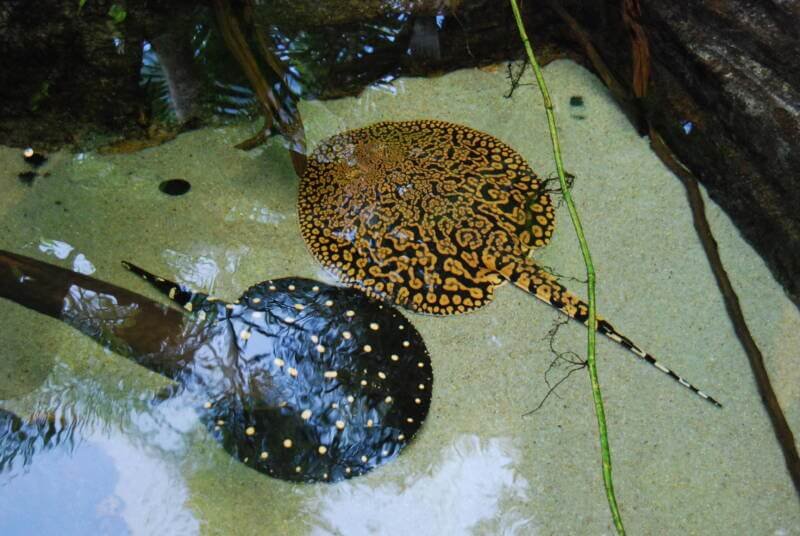
If kept well, these mysterious species become not only majestic showpieces but also very personable pets – almost like playful puppies!
Stingrays, like their names suggest, have stingers. This stinger is a barbed appendage that is located about two thirds the way down the tail.
And yes, their stings are poisonous.
In today’s article, we’ll go in-depth about this majestic family of fishes and how best to keep them in the home aquarium.
In this article
Common Types Of Freshwater Stingray
In the list below are a few species of freshwater stingrays that have become popular in the aquarium trade in recent years.
Most of these species can be found at your local fish store or from a breeder.
1. Potamotrygon Motoro (Ocellate river stingray, Motoro)
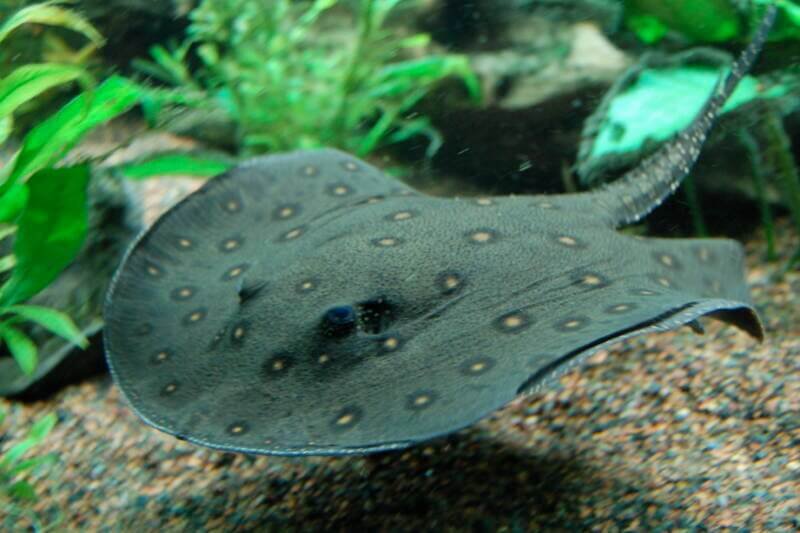
The most common of the lot, the Ocellate river stingray, sometimes called the Motoro, is a great stingray to start with.
The Motoro is a good first stingray because it is the most forgiving of all the species on this list.
It is a dark brown color with yellow or orange spots.
However, the Motoro is a large species and can grow up to 36 inches in diameter. If you intend to keep a Motoro, make sure you have adequate tank space.
2. Potamotrygon Jabuti (Pearl stingray)

The Pearl stingray is a beautiful stingray that is endemic to the Tapajos river system in the Amazon.
Most of the species on this list are endemic to a particular Amazonian river system.
This species grows slightly smaller than the Motoro and can reach sizes of up to 30 inches in diameter.
It has a light brown base with mottled circular orange patterns.
As the Pearl stingray ages, its light brown coloration generally becomes darker while its mottled patterns become less obvious.
This species is also a good choice for hobbyists looking to start keeping stingrays.
3. Potamotrygon Henlei (Polkadot Stingray, P12, Henlei)

The original polka-dot stingray, Potamotrygon Henlei, is one of the most majestic stingrays available in the trade.
We remember being in awe many years ago when they first appeared.
The black base color, coupled with white spots and a paddle tail made it very different from any other stingray before.
The Potamotrygon Henlei is also a large stingray and will require adequate space before commitment.
This species is usually kept by those who are looking to start raising black-based stingrays, as they are generally less expensive than their P13 counterparts.
4. Potamotrygon Leopoldi (Black Diamond, P13, Leo)
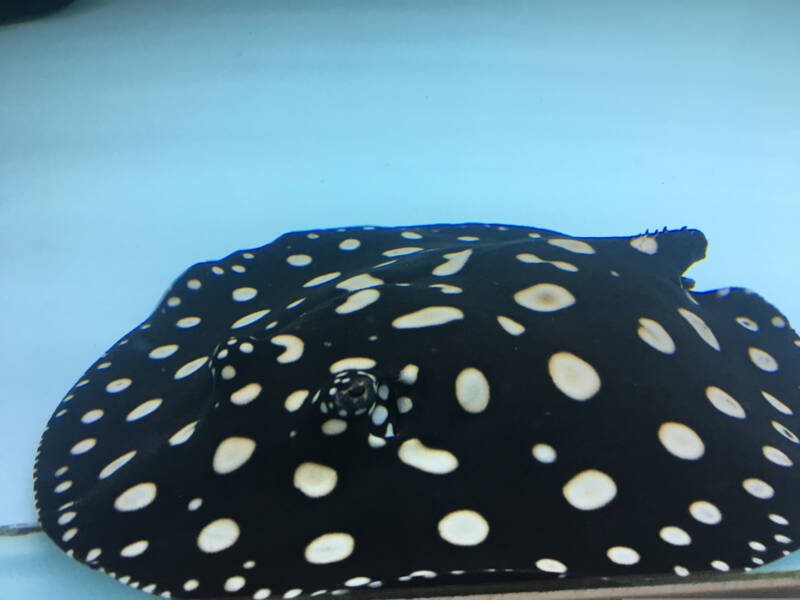
Usually considered the ultimate aquarium stingray, the Potamotrygon Leopoldi is even more majestic than its P12 counterparts.
While not all Potamotrygon Leopoldi are black diamonds, they are still considered variations of the same species.
Leopoldis have a much cleaner look and have much clearer white spots as compared to the Henlei.
At times, the Henlei may exhibit yellowish spots with a greyish base. However, you will not see this in a mature Leopoldi.
The Black diamond is a variation of the Leopoldi with an even cleaner jet black base with more white spots.
The size of the spots also makes a difference.
Black diamonds sometimes have donut-shaped white spots and white speckles near the perimeter of their disc.
Leopoldis should only be kept by experienced aquarists as they are more sensitive to water parameters than other freshwater stingrays.
5. Potamotrygon SP (Sp)
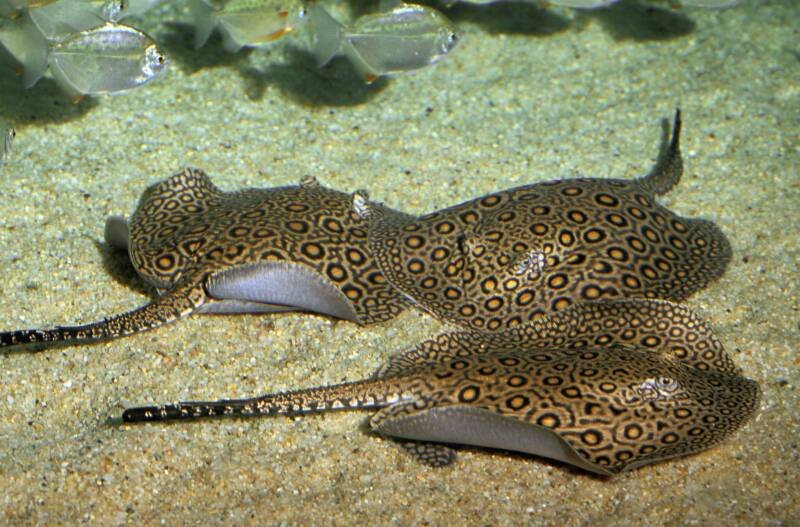
Due to freshwater stingrays being closely related, different members of a single genus can all hybridize with one another.
While it is considered undesirable to dilute the bloodline of a certain species, some breeders have created stunning variations of stingrays by interbreeding different species of freshwater stingrays.
Although most of the Sps are cheap, a few hybrid varieties top the charts of the most expensive freshwater stingrays.
They also tend to grow very large due to their mixed bloodlines.
What are Freshwater Stingrays?
Stingrays belong to a family of fishes that are related to sharks. Yes, you read that right, sharks!
As you probably already know, stingrays have a fascinating flat body shape, much like a pancake with a tail.
This shape, coupled with their cartilaginous skeleton, make them very effective bottom-dwelling hunters.
Most stingrays that we know of are marine fishes.
However, there is a small group of 33 species that exclusively reside in freshwater. The Potamotrygon family is the most prominent in the aquarium trade, as we’ll discuss below.
Freshwater stingrays, unlike other fishes, do not have scales and are covered only by a layer of skin that secretes a thin layer of mucus for protection.
And, of course, they sport stingers on their tails that serve as formidable weapons.
However, their sting is only a defense mechanism and is rarely used unless absolutely necessary.
Origins
Most of the freshwater stingrays we see today originate from the Amazon basin – in particular the Potamotrygon family, which we’ve mentioned earlier.

Comprising of 24 out of the 33 species of freshwater stingray, the Potamotrygon genus by far has the best survival rates in the home aquarium.
Husbandry improvements and a better understanding of the fish themselves have improved survival rates.
Until recent years, most of the fish in the trade were wild-caught, resulting in exorbitant prices and high mortality rates.
However, hobbyists and keepers have now bred these fish to an extent where there is no more need to obtain specimens from the wild.
Their natural environment usually consists of a deep layer of substrate, fallen trees, and leaf litter.
The amount of tannins in their native habitat lead them to prefer slightly acidic water.
Behavior
This family of fish, though carnivorous, is not particularly aggressive. They’d rather spend their time combing the riverbeds and substrate for food.
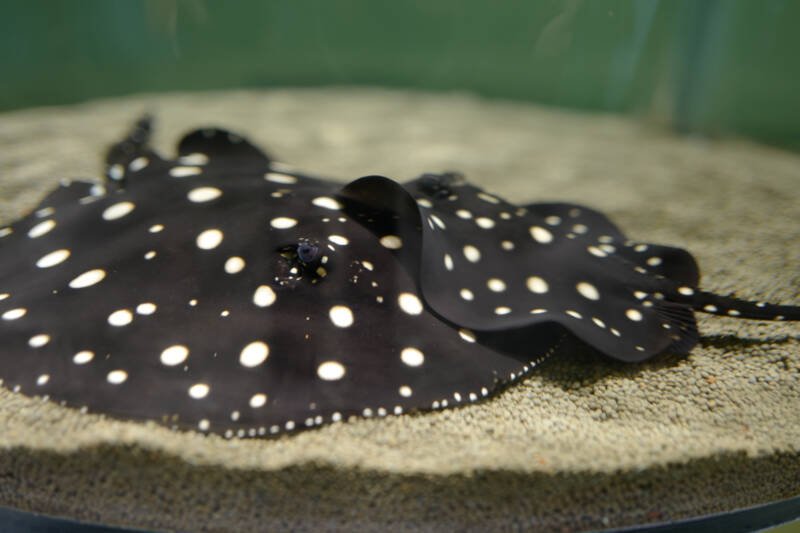
They are opportunistic feeders that will eat any fish small enough that comes too close.
Most often, though, they like to take the easy way out and hunt for stationary food items like clams and worms that hide in the substrate bed.
Sexually mature males do get aggressive when they are trying to mate. This behavior can seem quite violent when the male will bite and chew at the female’s body.
Otherwise, freshwater stingrays are very peaceful and can have very personable characters, making them an absolute joy to keep.
They are very inquisitive fish with definite minds of their own!
Size
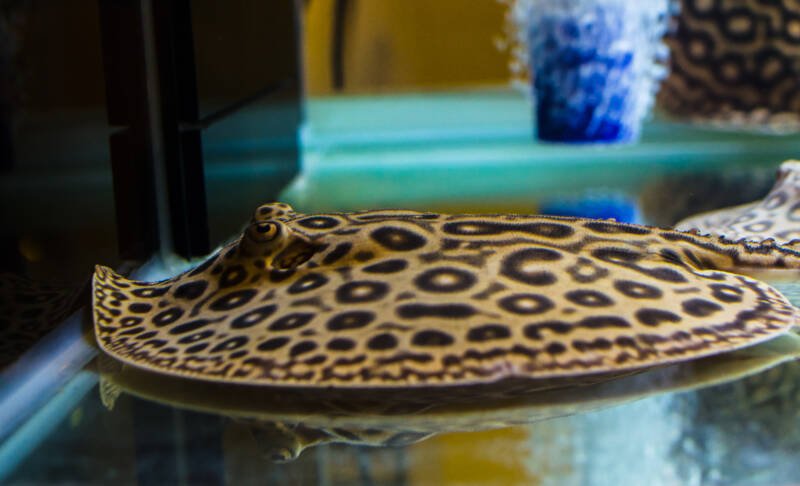
The freshwater stingray is a very large fish and, by all accounts, should only be raised by experienced keepers who understand their needs.
Some species like Potamotrygon Leopoldi and Potamotrygon Motoro can grow up to 36 inches in diameter if kept in the right conditions.
While it is more common for these fishes to be in the 30-inch range, you will still need to be prepared for them to grow continuously throughout their lives.
The size they reach in the aquarium is directly related to the amount of food they get. The more food that is made available, the larger they will grow.
Of course, this doesn’t mean you should starve your fish to keep it from growing larger.
Diet
As we’ve mentioned earlier, the freshwater stingray is a carnivore. That means they almost exclusively consume meat.
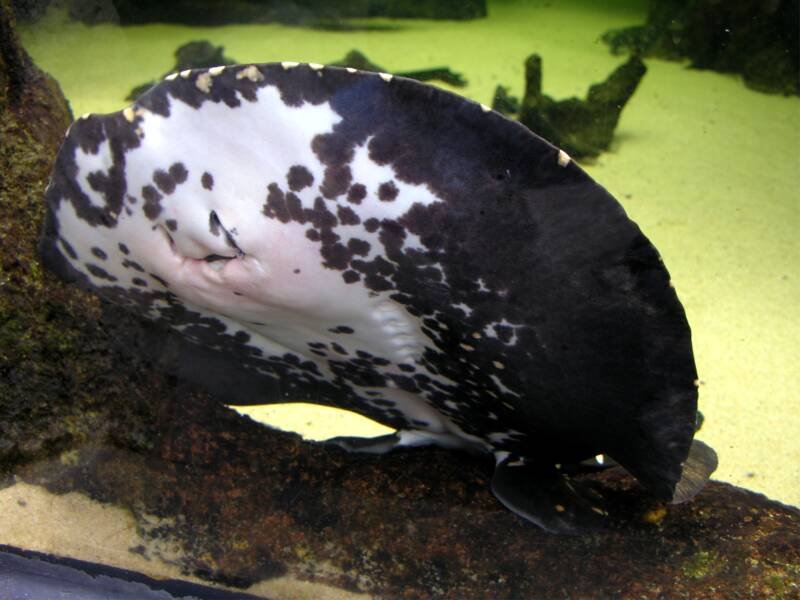
While there are some exceptions to this rule, most of their diet should only consist of animal matter.
In the wild, most of their diet consists of various worms, mollusks, and small fish that stray too close.
They have strong mouths with rows of small teeth designed for grinding up and breaking the shells of invertebrates.
In the home aquarium, however, most keepers opt to feed them with chopped fish and shrimp.
While some keepers do offer food items like ghost shrimp and black worms, there is a significant risk of parasites if the food comes from unfavorable conditions.
Usually, the live feed is used as a last resort if your stingray has stopped eating.
Live food is generally more enticing and can induce a better feeding response for sick or recovering stingrays.
Recent years have even seen commercial pellets being developed, especially for bottom-dwelling carnivores.
While these pellets have varying degrees of success with the fish, they are by far the most convenient option.
Sexing
Stingrays are sexually dimorphic. This means that males and females have visible physiological differences that distinguish them.
While it can be tricky to tell them apart before sexual maturity, with a little practice, you’ll be a pro!
Males have a pair of claspers that are used for insemination during mating.
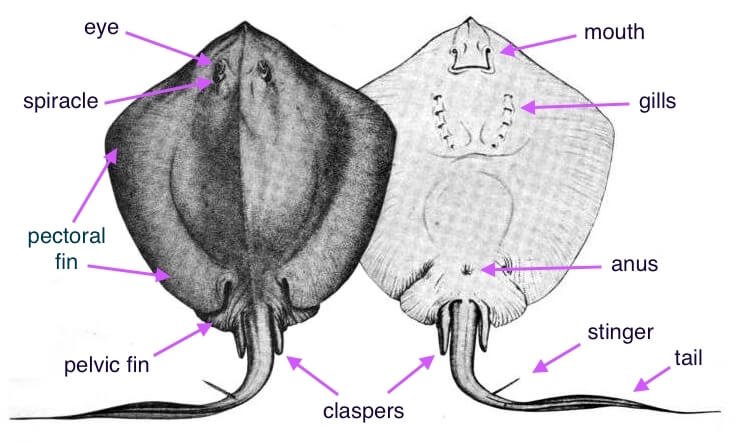
These claspers are located on their underside at the base of the tail, in between their pelvic fins.
The claspers are more obvious as the stingray ages and reaches sexual maturity. They look like little sausage rolls at the base of their tail.
Before sexual maturity, these claspers are not obvious, but they are still there.
To accurately sex a young stingray, it is easier to take it out and place it in a transparent container so the underside can be clearly seen.
The claspers will look like pointed extensions of the pelvic fin. They are absent in female stingrays.
Aquarium Size
Freshwater stingrays are very large and require big tanks.
If you are not ready to commit enough space, your stingray will suffer and most probably die.
Before we talk about how big the tank should be for a single stingray to live comfortably, we need to understand the important aspects to consider.
Floorspace
Stingrays appreciate lots of floorspace.
As they grow large, they’ll need NO LESS than three by five feet worth of floorspace available to them.
A tank with these dimensions will be able to house a maximum of two freshwater stingrays comfortably into adulthood.
Floorspace is also important because larger stingrays in small tanks will have a hard time turning as they navigate the bottom of the tank.
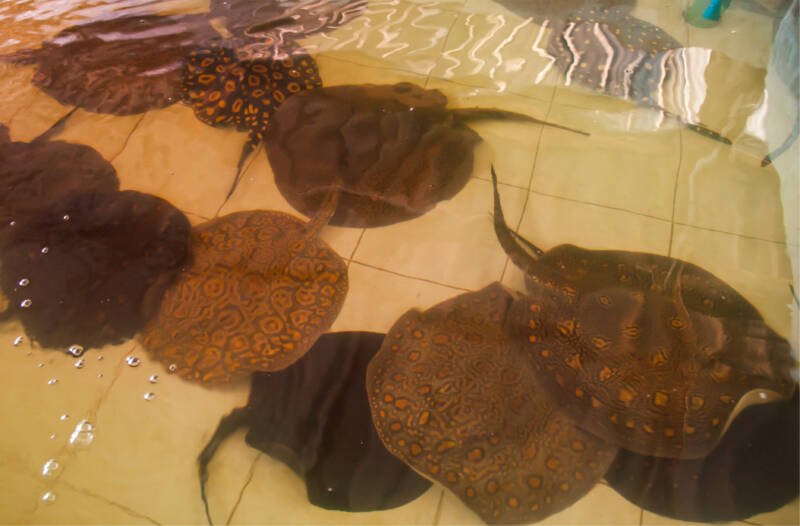
Height
Height is the least important factor when deciding the aquarium size.
Stingrays usually find security in the substrate at the bottom of the tank. Hence, a height of two feet will be more than sufficient for them.
Having a shorter tank will also aid with the weekly aquarium maintenance.
Equipment

Freshwater stingrays are notorious for increasing the bioload in the tank tremendously.
Due to their size and voracious appetite, freshwater stingrays require a filtration system that can handle such loads.
Most keepers opt to have a sump system installed to increase the volume of water in the tank as well as increase the amount of filter media to handle the heavy bioload.
This increase in filter media also helps to bolster essential nitrifying bacteria that will bring down levels of nitrate, nitrite, and ammonia, all of which are toxic to stingrays even at moderate levels.
While most other aquarium applications might recommend a cycle rate of 10 times the tank’s volume per hour, we recommend somewhere between 15-20 times the volume for stingrays.
Although these fish prefer low-flow water, a higher turnover rate will reduce the bioload in the tank.
It is also critical that your tank is well and fully cycled before the introduction of any freshwater stingray because they are extremely sensitive to water parameter fluctuations.
Stingrays do not tolerate mistakes well, and it would be best to remember that.
A robust biological filtration system is perhaps the most essential piece of ‘equipment’ you can have when keeping freshwater stingrays.
Designing in a sump increases the space available for filter media such as bio rings which help increase the surface area for beneficial fauna to flourish.
Water Parameters
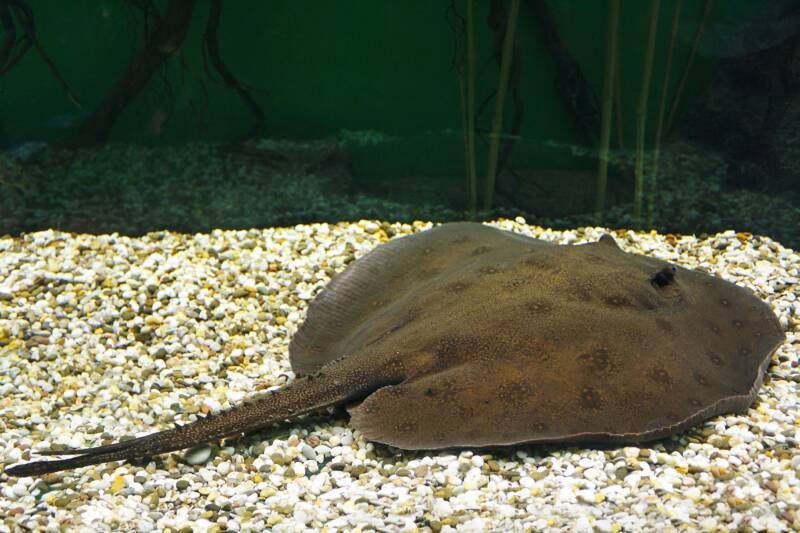
Freshwater stingrays can accept a relatively wide spectrum of parameters as long as they’re kept consistent. What they cannot withstand are fluctuations.
In their natural environment, stingrays prefer slightly acidic water (mainly due to the tannins present). To mimic this, we usually keep our stingrays in the pH range of 6.5 – 6.8.
Freshwater stingrays are also very sensitive to ammonia, nitrites, and nitrates. Hence, it is best to keep them at or close to zero.
As for temperature, they are fine with anything from 70°F to 82°F.
As long as you keep your stingrays in water that falls within these ranges and does not change much, they will be happy and healthy.
Substrate and Decor
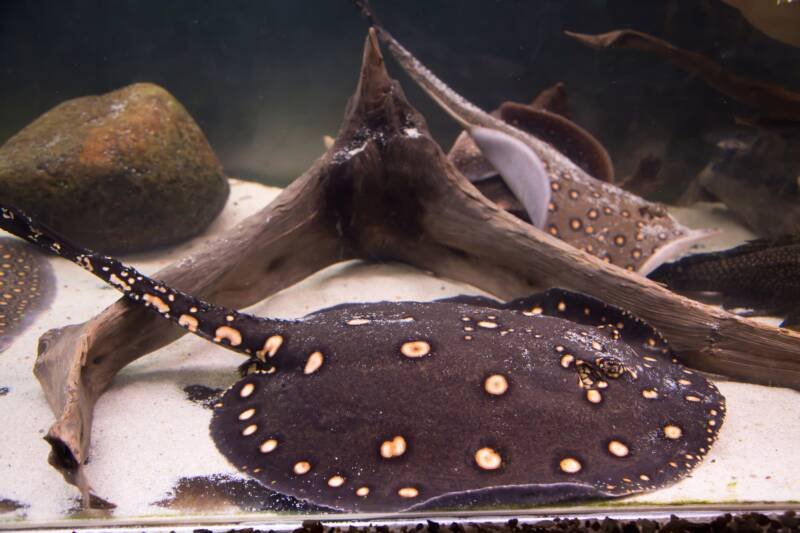
More and more keepers nowadays opt to keep freshwater stingrays without any substrate in the tanks.
While doing this makes things more convenient for the aquarist, it can sometimes cause stress to the rays (especially if the tank is heavily stocked with other fishes) and offers them no place to seek shelter.
For our stingrays, we choose to maintain a 1-3 inch layer of size zero river sand. This is because stingrays find security by burrowing, so that’s how they will spend much of their time.
However, we know many freshwater stingray breeders who have raised stingrays from pups without any substrate.
We also usually add little to no decor into our stingray tanks because stingrays like to explore every inch of floorspace available, making floorspace a very valuable asset.
However, if you have a big enough tank, there is no harm in a bit of decor like bogwood and stones.
Plants of any kind are not recommended because the rays are likely to burrow in the sand and uproot everything.
Feeding your Freshwater Stingray
Feeding is usually an easy process for an already established stingray. They are voracious eaters and will even eat out of your hand once they are comfortable enough.
While there is no immediate danger when feeding these fishes, it does get messy. Some hazards can crop up if you have a group of zealous freshwater stingrays trying to have a meal together.
The danger comes about when overly excited stingrays start thrashing around for food, sometimes swinging their tails.
As a stingray keeper, it is essential to always keep an eye out for their stinger no matter how calm the situation might be.
Another big problem when trying to feed stingrays is the size of the food item. They do not have very big mouths. As such, large food items must be specially prepared.
Most owners also opt to feed their stingrays just enough to keep them full for a few hours since they are very messy eaters.
We feed our stingrays thrice daily. Each meal consists of just enough for them to consume within about five minutes.
After each feeding, we vacuum and remove the remaining food in the tank.
Dealing with Freshwater Stingray Barbs
Freshwater stingrays shed their barbs once every few months. The frequency of this depends on the individual and is different for each species.
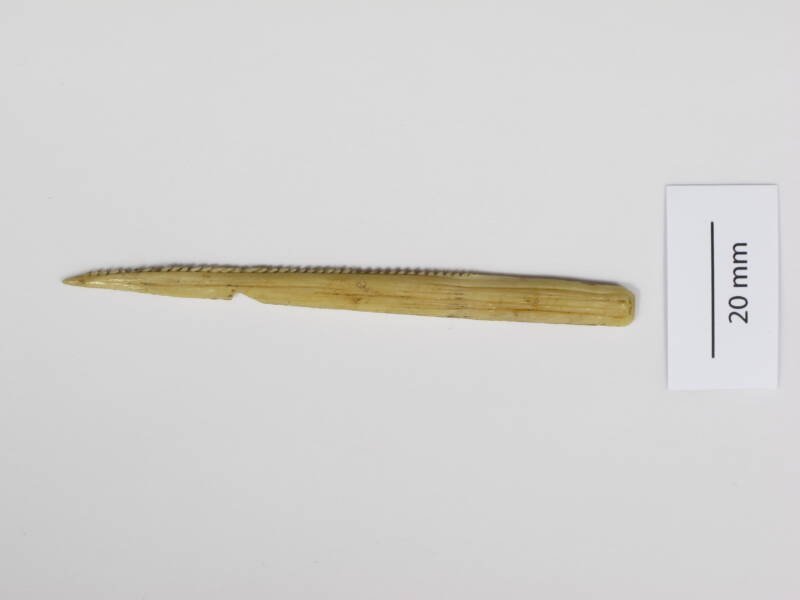
When the barbs are shed, they are still poisonous and remain dangerous for several days. It is best to use gloves when removing the shed barbs from the tank.
These shed barbs should be removed as soon as possible to prevent them from impaling your stingrays in the tank.
Given the small space within a tank and the fact that barbs sink to the bottom where the stingrays live, this has been the fate of far too many aquarium rays in the past.
As long as the stinger barbs are removed promptly, your fish will be fine.
Breeding Freshwater Stingrays
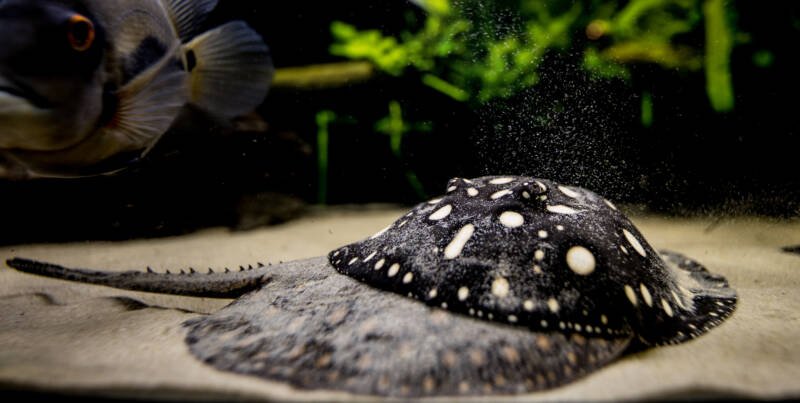
Surprisingly, breeding freshwater stingrays is the easiest part of keeping them.
For those of you who do not yet know, they give birth to live young!
All you need is a pair of mature adult stingrays, and they will most probably breed. Sexual maturity is usually reached between 8 months to 1.5 years.
Males mature faster than females and will be ready to mate at about 12 inches in diameter. Females, on the other hand, should only be bred once they have reached 15-18 inches.
It is also very important that both fishes are in good health before attempting to breed them. Mating occurs year-round so there is no need to wait for a specific season.
Females can give birth a few times a year.
However, because breeding is a stressful ordeal, we recommend breeding your female no more than twice a year.
The Mating Ritual
Once ready, the male will begin chasing the female around the tank. He will try to cling on to her by biting onto the perimeter of her disc.
The process can get relatively violent but is entirely natural. It is common for older females to have bite marks around the perimeter of her disc.
Once the female gets tired, she will accept the male, and he will proceed to insert his claspers into her cloaca.
The actual mating does not take more than a minute, and insemination happens internally.
The male will sometimes swim inverted to get into a better position to insert his claspers. After mating is completed, they will separate.
Some keepers opt to separate the males after breeding to prevent further stress to the female.
Gestation and Birth
Female stingrays are capable of giving birth to 1–12 pups with each pregnancy.
Some species can give birth to more pups than others, and larger females tend to have larger litters.
The gestation period usually lasts about three months, with different species differing by a few days each. The female will begin to look swollen closer to the due date.
At this point, it’s important not to stress the female out, or she may have a miscarriage or premature birth.
It is completely normal for the female to look bloated if she has a large litter.
When the female is ready, she will give birth to her pups.
They are born as fully-formed miniature versions of their parents.
Caring for Pups
Newborn pups are susceptible to everything. So, for the first few weeks of their lives, it is best to keep them in the same water in which they were born.
What we usually do is to isolate the female a few weeks before she is due. This gives her the chance to relax and offers the pups a better chance at survival.
Mothers very rarely eat their pups. However, if other stingrays are present, cannibalism is a significant danger.
Once born, we separate the pups and place them in a blacked-out floating container in the mother’s tank for the first two days to let them settle down.
After this, they can be removed and placed in a grow-out tank.
Feeding pups can be tricky as they usually only take live food at the start.
Some everyday food items that will entice them are tubifex worms, bloodworms, blackworms, and ghost shrimp.
It takes about a month for them to grow to a stable size of four inches or so before they can be started on the same foods the adults take.
However, it is important to note that pups have small mouths and can be quite finicky when it comes to changes in diet.
We usually feed our pups three times daily as well!
If kept properly, the pups should reach a stable size of five inches within three months or so before they can be sold or given away.
Closing Thoughts
Keeping freshwater stingrays is an immensely rewarding experience.
From experience, we can tell you that they are among the most personable fish you can possibly keep.
You will very likely fall in love with them.
If you are a beginner looking to keep your first ray, be sure to do adequate research as they are both financially and mentally taxing animals to keep.
However, if done well, you will be rewarded with an experience like no other.Freshwater stingrays are exceedingly smart.
Some of ours recognize our faces and will swim to the top of the tank to spit water at us to get some attention when we walk past!
We hope you’ve found this article fun and informative.
Please leave us your questions in the sections below!